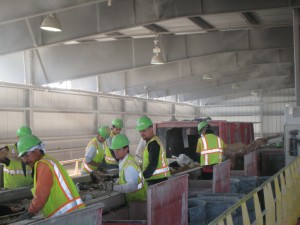Water Sprays
- Generally, seen in focused areas of use to contain dust such as on an assembly conveyor belt
- Use low water pressure systems
- Often use compressed air to atomize water
- Nozzle tips have “wider” openings and cannot capture smaller dust particles
- Flow rates are not as easily regulated
Wetting
- Generally, effective for outdoor containment such as roadside construction dust management
- Temporary solution as the wet “dirt” will dry and become dust again
- Wetting does not regulate water flow or manage runoff
- Can cause dampness, wet floors, or wet materials that can spoil (i.e. wood and paper product manufacturers wish to avoid soggy product that can clog equipment resulting in production down-time and huge clean up costs)
Fog/Mist
- High pressure concentrated fog application will capture the dust without adding moisture or “wetting” the surrounding area
- Temperature controls can account for humidity levels
- Nozzle sizes are designed to create droplets that have an average diameter in the 10-micron range
- Most effective in semi-enclosed areas with minimal wind and humidity
Sources of Fugitive Dust that respond to Fog/Mist suppressant system
- Sand, gravel, and rock crushing
- Farming Operations i.e. soil mixing
- Food and Agriculture Processing (grain dryers, mills, animal feed)
- Manufacturing (cereal, wood & paper products that produce dust wood chips, etc.)
- Mining and Mineral Processing
- Construction (concrete batch plants)
How It Works
 Fogging systems use high pressure pumps to atomize water creating a fog atmosphere that consists of droplets that have an average diameter of around 10 microns. In effect, dust particles are absorbed by the fog droplets and fall to the ground.
Fogging systems use high pressure pumps to atomize water creating a fog atmosphere that consists of droplets that have an average diameter of around 10 microns. In effect, dust particles are absorbed by the fog droplets and fall to the ground.Koolfog uses a “positive displacement” pump to produce pressures in excess of 1000 psi. Fog nozzles, designed specifically for size of location, water usage, and velocity, have an opening not much larger than the width of a human hair. The fog nozzle tips produce droplets in this 10-micron range to efficiently capture dust particulate matter that would otherwise escape into the air.
Prevention & Compliance using Dust Control Methods Back to Dust Control Fugitive Dust Control Case Study



